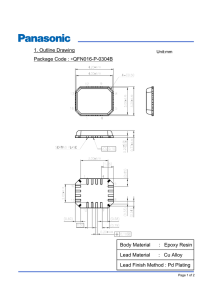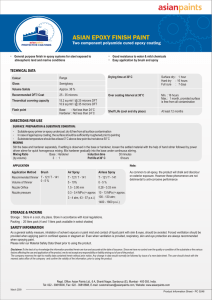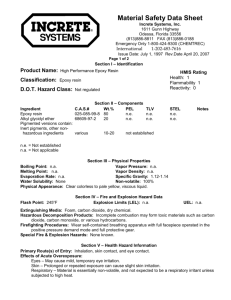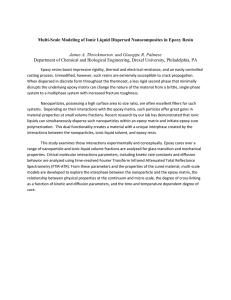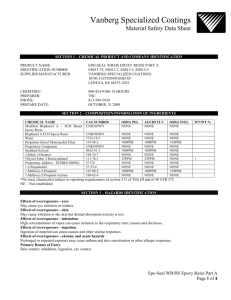The Simple Guide to Epoxies
advertisement
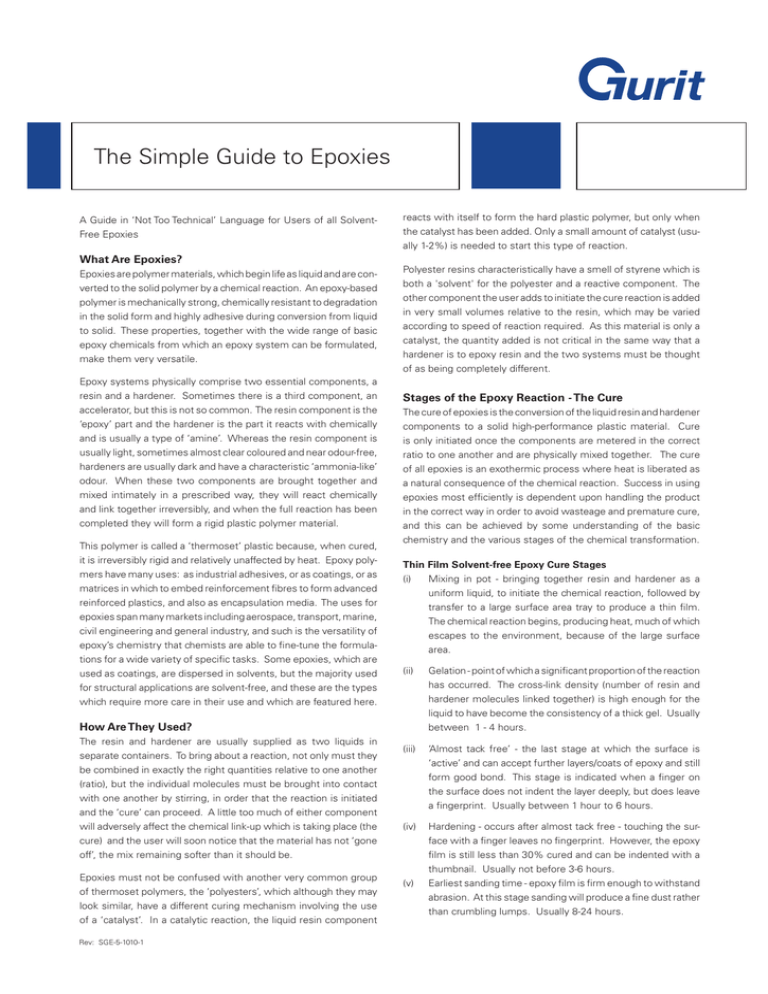
The Simple Guide to Epoxies A Guide in ‘Not Too Technical’ Language for Users of all SolventFree Epoxies What Are Epoxies? Epoxies are polymer materials, which begin life as liquid and are converted to the solid polymer by a chemical reaction. An epoxy-based polymer is mechanically strong, chemically resistant to degradation in the solid form and highly adhesive during conversion from liquid to solid. These properties, together with the wide range of basic epoxy chemicals from which an epoxy system can be formulated, make them very versatile. Epoxy systems physically comprise two essential components, a resin and a hardener. Sometimes there is a third component, an accelerator, but this is not so common. The resin component is the ‘epoxy’ part and the hardener is the part it reacts with chemically and is usually a type of ‘amine’. Whereas the resin component is usually light, sometimes almost clear coloured and near odour-free, hardeners are usually dark and have a characteristic ‘ammonia-like’ odour. When these two components are brought together and mixed intimately in a prescribed way, they will react chemically and link together irreversibly, and when the full reaction has been completed they will form a rigid plastic polymer material. This polymer is called a ‘thermoset’ plastic because, when cured, it is irreversibly rigid and relatively unaffected by heat. Epoxy polymers have many uses: as industrial adhesives, or as coatings, or as matrices in which to embed reinforcement fibres to form advanced reinforced plastics, and also as encapsulation media. The uses for epoxies span many markets including aerospace, transport, marine, civil engineering and general industry, and such is the versatility of epoxy’s chemistry that chemists are able to fine-tune the formulations for a wide variety of specific tasks. Some epoxies, which are used as coatings, are dispersed in solvents, but the majority used for structural applications are solvent-free, and these are the types which require more care in their use and which are featured here. How Are They Used? The resin and hardener are usually supplied as two liquids in separate containers. To bring about a reaction, not only must they be combined in exactly the right quantities relative to one another (ratio), but the individual molecules must be brought into contact with one another by stirring, in order that the reaction is initiated and the ‘cure’ can proceed. A little too much of either component will adversely affect the chemical link-up which is taking place (the cure) and the user will soon notice that the material has not ‘gone off’, the mix remaining softer than it should be. Epoxies must not be confused with another very common group of thermoset polymers, the ‘polyesters’, which although they may look similar, have a different curing mechanism involving the use of a ‘catalyst’. In a catalytic reaction, the liquid resin component Rev: SGE-5-1010-1 reacts with itself to form the hard plastic polymer, but only when the catalyst has been added. Only a small amount of catalyst (usually 1-2%) is needed to start this type of reaction. Polyester resins characteristically have a smell of styrene which is both a 'solvent' for the polyester and a reactive component. The other component the user adds to initiate the cure reaction is added in very small volumes relative to the resin, which may be varied according to speed of reaction required. As this material is only a catalyst, the quantity added is not critical in the same way that a hardener is to epoxy resin and the two systems must be thought of as being completely different. Stages of the Epoxy Reaction - The Cure The cure of epoxies is the conversion of the liquid resin and hardener components to a solid high-performance plastic material. Cure is only initiated once the components are metered in the correct ratio to one another and are physically mixed together. The cure of all epoxies is an exothermic process where heat is liberated as a natural consequence of the chemical reaction. Success in using epoxies most efficiently is dependent upon handling the product in the correct way in order to avoid wasteage and premature cure, and this can be achieved by some understanding of the basic chemistry and the various stages of the chemical transformation. Thin Film Solvent-free Epoxy Cure Stages (i) Mixing in pot - bringing together resin and hardener as a uniform liquid, to initiate the chemical reaction, followed by transfer to a large surface area tray to produce a thin film. The chemical reaction begins, producing heat, much of which escapes to the environment, because of the large surface area. (ii) Gelation - point of which a significant proportion of the reaction has occurred. The cross-link density (number of resin and hardener molecules linked together) is high enough for the liquid to have become the consistency of a thick gel. Usually between 1 - 4 hours. (iii) ‘Almost tack free’ - the last stage at which the surface is ‘active’ and can accept further layers/coats of epoxy and still form good bond. This stage is indicated when a finger on the surface does not indent the layer deeply, but does leave a fingerprint. Usually between 1 hour to 6 hours. (iv) Hardening - occurs after almost tack free - touching the surface with a finger leaves no fingerprint. However, the epoxy film is still less than 30% cured and can be indented with a thumbnail. Usually not before 3-6 hours. (v) Earliest sanding time - epoxy film is firm enough to withstand abrasion. At this stage sanding will produce a fine dust rather than crumbling lumps. Usually 8-24 hours. (vi) Earliest loading time - for adhesives, this is the time after which sufficient cure has occurred to enable the polymer to be loaded without it stretching irreversibly, or breaking. However, this is rather arbitrary and it is better to wait for full cure. (vii) Full cure - at room temperature ‘full cure’ for most epoxies means 80-90% of their theoretical maximum crosslinking, which can only be obtained by heating to higher temperatures (40-100°C typically). ‘Room temperature cure’ epoxies are designed to give good performance even though not cured to their theoretical maximum. ‘Full cure’ is usually after a minimum of one week. Essential Practical Notes for Users of Gurit SolventFree Epoxy Systems Being sophisticated chemicals, epoxies respond to careful use. Epoxy ‘systems’ (the particular epoxy resin and hardener combination) vary considerably depending on what particular task they are designed to perform. Therefore, one system will display characteristics and working properties which may vary from another. Reading the product data sheet which accompanies the product is therefore strongly recommended in order that the user achieves the expected results. Although variation can be expected, all systems have some common requirements which can be considered as the ‘general rules’ of using epoxies and these are outlined as follows: 1. Store The Resin And Hardener Components In a Warm Environment Before Use If the storage temperature is too cold, the hardener and particularly the resin will become too thick to both measure out and to mix efficiently. A resin which has the viscosity of thick ‘syrup’ is too thick to use and should be warmed until it is the consistency of thin ‘motor oil’. Resin and hardener are usable at any temperature above 15°C, but 18-25°C is considered ideal. Storing the containers either indoors at room temperature or warming the contents prior to use by a safe heater is good practice. Some professional users, who have limited heating facilities, construct a heated cabinet (using lightbulbs) as an economical method of maintaining their epoxy at a suitable temperature, and this technique has proved very successful. 2. Use The Products In A 'warm' Environment It is the nature of epoxies that they cure by chemical reaction, the rate of which is temperature dependent. In fact, for every 10°C rise in temperature, The chemical reaction rate will double. In order that epoxies can be fitted in to a wide spectrum of uses and temperature requirements, most SP epoxies usually have two or more hardeners giving different reaction speeds. The user should acquaint themself with the expected working characteristics given by each system before commencing the work. The relevant information is always included in the product data sheet. Ideally, no epoxy should be left to cure at a temperature of lower than 12-15°C, even using fast hardener. This applies particularly to coatings. In reality, even though the epoxy may appear to be ‘hard’ and perform its task satisfactorily, the cure may not be complete, particularly with epoxy adhesives. It may take a prolonged period to Rev: SGE-5-1010-2 cure fully at such ‘low’ temperatures and some epoxy reactions may only be completed by the subsequent application of elevated temperatures. Whereas warm, thermostatically controlled workshops are the best solution, these are expensive to run and certainly are in the minority, at least in the marine industry. Certain less expensive techniques however, can be very useful for raising the cure rate. Local high temperature levels are effective for initiating the cure and, if used sensibly in short bursts, do not have the expected result of causing the mix to harden prematurely. An electric hot air gun is particularly invaluable when using epoxy in cold conditions (down to 5°C), to aid application. The hot air gun (paint-stripper type) can enable small scale work to proceed in cold cure environments. Coating and laminating applications have benefitted most but the technique can also assist glue application or the application of epoxy fillers. But care should be used to ensure that heat is only applied to the surfaces to be bonded or coated and in a limited number of short bursts. 3. Measure The Resin And Hardener Components Accurately In The Correct Mix Ratio Read the data sheet supplied with the product to determine the ratio of your particular epoxy. Although usually given on a volume basis (e.g. 5:2 parts resin to hardener respectively), some systems also give a weight ratio, which is nearly always different. For instance, a system of 5:2 mix ratio by volume may be 3:1 by weight. The following methods are available to the user for metering purposes: Graduated Syringes 50cc and 10cc syringes are two convenient sizes that are easily obtainable. The larger one should be reserved only for the resin and the smaller one for the hardener. Used in this way they do not require cleaning after use. Simply allow each to drain on to some absorbent paper. Syringes are ideal for measuring out small volumes of less than 200cc and certainly the most economical, accurate method for volumes of less than 20cc. However, when using syringes on the small 1kg size packs or smaller, plastic extension tubes (which are available in the SP syringe kit) should be fitted. Syringes are consistently accurate and convenient to use and recommended for packs up to 1kg size. Non-Calibrated Mini-Pumps These, the smallest size of mini-pumps, are designed to fit on top of the containers of small pack sizes of resin and hardener, replacing the container caps. These non-calibrated pumps dispense approx. 7cc of liquid and when fitted should be used on the ‘number of strokes principle’ where the number of strokes of resin (always the greater proportion) to hardener corresponds to the system mix ratio, e.g. 5:1ratio = 5 strokes of the resin pump to 1 stroke of the hardener pump. Calibrated Pumps (Maxipumps) These fit all except the sub-1kg and 1kg size packs and, because the pumps are calibrated, work on the principle of one stroke resin to one stroke hardener to give the correct metered ratio amount of resin and hardener. Larger volumes of mixed resin/hardener are obtained by several equal strokes of the resin pump and hardener pump. Each pack size and each system has its own designated calibrated pump pack, and each cannot be used with any other system or pack size. Graduated Re-Useable Mixing Pots These are graduated up to 500cc and are useful for all systems where volumes required in one mix are greater than 150cc. They are commonly the preferred metering system when the total mixed volumes required are 400-500cc. They are made of flexible plastic, to which the epoxy will not adhere. Thus they can be re-used by allowing the remaining epoxy to cure in the pot, which can then be ‘popped’ out by flexing the container. Electronic Scales Weight measurement is always the most consistently accurate measurement for any system for volumes over 200cc. We recommend scales with a tare (reset to zero) facility of 2kg and 5kg capacity where the maximum mix required may be up to 1.5 litres or 4 litres respectively. Metering using scales is becoming increasingly popular and is particularly convenient if different epoxy systems or different size packs are being used which would otherwise require a range of specific pump dispensing systems. 4. Mix The Resin And Hardener Components Thoroughly After Metering No reaction between resin and hardener will occur, even at the interface of the two liquids, if they are not physically mixed together for a suitable period. Stirring by hand with a suitable flat-sided stirring stick and scraping round the sides of the container should be done for a period of not less than 1-2 minutes, depending on volume. Electric stirrers are efficient but do not touch the container sides, and therefore this method should always be accompanied by a final hand stirring to mix material stuck to the container side walls and base. 5. Mix Only Sufficient Product That You Can Use Conveniently It is relatively common to find users, who are not familiar with epoxy systems, mixing up too great a volume and that a proportion of the mix ‘hardens’ in the pot before being removed for use. All resin and hardener mixes generate heat so do not be surprised if you detect a heat build-up, however small, in the base of your mixing container. This heat build-up signals that the material will soon become unuseable and is particularly noticeable when large volumes are mixed. Using the mixed product is somewhat of a ‘balancing act’ - the aim of which is to remove material from the pot for use at a rate which is faster than the build-up of heat in the container, which is tending to make the product unuseable. If epoxy is simply left in the container in large volumes, considerable heat will build up and an uncontrollable 'exotherm' will result. This happens when the retained heat speeds the reaction, which in turn generates more heat, further speeding the reaction, and so on. If the user mixes only sufficient for use within the working time of the product, none or little detectable heat will be felt. For larger volumes (over half a litre), transferring mixed resin and hardener from the mixing vessel into a shallow container or tray is strongly recommended. Rev: SGE-5-1010-3 Once the epoxy mix is in a thin film, the heat generated is readily liberated and the material stays relatively cool, giving a suitably long working time. The shallow tray pot-life can typically be ten times the life in the mixing pot before the material becomes unworkable. In practice, one should always be conscious of the limited amount of time available to both transfer the epoxy from the mixing pot to the work and to manipulate the product on the working surface. The product data sheet will give some guidance on this, but it is always a good idea for the sake of economy to start with small volumes, until familiarisation will allow larger volumes to be mixed. Making Glues and Filling Compounds - Adding Fillers Once mixed, the combined epoxy resin and hardener is a pourable, thin liquid mixture. Whilst this is in itself can be used as an adhesive, it is only recommended for flat, tightly-mating surfaces not for anything rough, absorbent or sloping, as it is likely that the thin liquid will simply leak away before sufficient gelation has occurred, resulting in the joint being starved of glue. For use as an adhesive or a filler (for fairing, etc.) one or more filler powder ‘additions’ are generally required to combat the above mentioned effect. Understanding which fillers to use and in what sort of proportion to add them to the mixed epoxy is a necessary part of gaining the full benefit of using epoxies in a workshop environment. Fillers are not commonly used either for fibre laminating, where they will compromise fibre wet-out, or for coating applications, but for other uses they are very common. Fillers can be broadly categorised as ‘fibrous’ (Microfibres), ‘hollow sphere’ (phenolic Microballoons & Glass Bubbles) and ‘flake’ (Colloidal Silica). For all bonding applications, microfibres are the most useful as they absorb and retain resin. However, for filling and fairing work, a type of filler which displaces resin, rather than absorbing it will be more appropriate, e.g. phenolic microballoons. All of these fillers can generally be regarded as the ‘primary’ fillers, to be added in the largest proportion. Colloidal Silica can be regarded as a ‘resin modifier’ giving non-sag or ‘thixotropic’ qualities and it is generally used in combination with the above types. Fillers do not require accurate measurement - the aim is to achieve a desired ‘consistency’ for any particular job and the amount to be added can simply be assessed by ‘feel’ and visual judgement. For general bonding (at least on semi-cured porous surfaces), to aim at a ‘wallpaper-paste mix’ is more understandable than giving a precise ratio by weight or volume for the amount of microfibres which should be added. For filling and fairing, consistency of the mix may be varied according to build required. For higher build, simply add more of the ‘hollow sphere’ type filler. When the consistency is judged to be correct the mix will invariably still display a slight tendency to ‘sag’ (test by lifting a small volume on mixing stick) but this can be easily corrected by adding small volumes of colloidal silica until the desired ‘non-sag’ quality is reached. Exceeding this point will simply make the mix harder to sand when it has cured and is therefore undesirable (but not catastrophic!) Surface Preparation Whether one is using epoxy as a coating, filler or laminating resin, the same surface preparation treatment applies. In order for the epoxy to adhere adequately, surfaces must be clean, free of dust and any other loose surface material, and not have any traces of greasy or oily contamination. Any previous coating on the surface to be bonded should be removed as it is likely that the epoxy will have higher bond strength than the coating. The general preparatory treatment consists of an abrasion stage followed by cleaning with a volatile liquid which will evaporate completely. If the surface is oily or greasy then this should be a suitable organic solvent. For example acetone is acceptable but white spirit is not. Some surfaces (e.g. metals, certain woods and some plastics) require a more specialised pre-treatment, which is specific to that material and often complex to carry out, in order to ensure good long term performance. Specific details of surface pre-treatment can be obtained from SP on request. Attention should be paid to using the correct solvent for surface cleaning and the user should be aware of the importance of any other inappropriate cleaning products that may previously have been used on the surface. Any incompatibility between surface and the epoxy will easily manifest when coating, where the epoxy is in its least viscous state. When using epoxy as an adhesive, surface roughness is generally preferred rather than detrimental, as the epoxy’s low shrinkage and facility to be filled enables it to cope well with surface irregularities. The roughness in itself can, through increasing the bonding area, also lead to a more efficient bond. Cleaning Equipment Once solvent-free epoxies have cured beyond the ‘tacky’ stage, they gradually become more immune to being softened by the effect of solvents until, when hard, they are completely unaffected. Up to the ‘syrup’ stage, brushes and equipment can be cleaned with Gurit Fast Epoxy Solvent (Solvent A) or Gurit Standard Epoxy Solvent (Solvent B). Gurit Standard Epoxy Solvent (Solvent B) is also useful for restoring brushes. Gurit Hand Cleaner, besides being indispensable for cleaning resin from the skin (on no account should solvent be used for this despite the temptation) also restores brushes after having first being washed in solvent. The cleaner is washed away with water and brushes dried before re-use. selected to give each system its desired characteristics, As with any chemical, poor handling or misuse could be potentially hazardous to health, therefore it is essential that the appropriate safety procedures are observed for the safe handling and use of these products. As is now the law, full health and safety data sheets (MSDS) are available for each individual product supplied by Gurit. In general, the epoxy component of a solvent-free system is a skin irritant, while the hardener is a corrosive liquid. However, each formulated component has a hazard level indicated by a standard container warning label, similar to those found on bleach, methylated spirits and other domestic chemicals. These also indicate the precautions necessary before handling the product and what to do in the event of an emergency. In addition, the product data sheet contains general information on the safe handling of the product. Notice All advice, instruction or recommendation is given in good faith but the Company only warrants that advice in writing is given with reasonable skill and care. No further duty or responsibility is accepted by the Company. All advice is given subject to the terms and conditions of sale (the Conditions) which are available on request from the Company or may be viewed at the Company’s Website: www.gurit.com. The Company strongly recommends that Customers make test panels and conduct appropriate testing of any goods or materials supplied by the Company to ensure that they are suitable for the Customer’s planned application. Such testing should include testing under conditions as close as possible to those to which the final component may be subjected. The Company specifically excludes any warranty of fitness for purpose of the goods other than as set out in writing by the Company. The Company reserves the right to change specifications and prices without notice and Customers should satisfy themselves that information relied on by the Customer is that which is currently published by the Company on its website. Any queries may be addressed to the Technical Services Department. Epoxy on plastic or smooth metal equipment may be scraped off and cleaned with Gurit Standard Epoxy Solvent (Solvent B) whilst still soft, or alternatively left to harden and cure after which it can be cracked away (off flexible plastic) or sanded off (from metal). Gurit guides are being continuously reviewed and updated. Please ensure that you have the current version before using the product, by contacting Gurit Marketing Communications and quoting the revision number in the bottom left-hand corner of this page. Alternatively, the latest version can be downloaded from our web Health and Safety site: www.gurit.com Gurit epoxy resins, hardeners and other products are high performance materials. They are a complex blend of chemicals specially E gurit@gurit.com W www.gurit.com Copyright © 2002 All rights reserved. All registered trademarks in this document are the property of their respective owners. Specification subject to change at any time and without notice. Rev: SGE-5-1010-4
